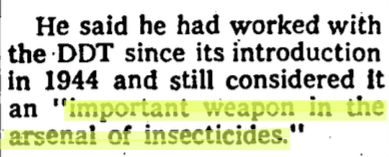The DDT Controversy: Science and Society
After its discovery in 1940, DDT’s popularity exploded as it came to be known as an effective, long lasting insecticide that could control the spread of malaria and other infectious diseases. Despite this, concerns about DDT’s safety and impact on the environment soon emerged, peaking in the 1960s.
The document we are highlighting today is written in 1969 by the Monsanto Company. It includes a letter from a Tom C. Ford and several newspaper clippings.
Ford’s memo grouses about how Robert Risebrough, a prominent scientist, once testified that PCBs were “widely distributed contaminants” but had recently declared that DDE, a similar compound to DDT, was in fact to blame for thin eggshells.
To further illustrate the polarizing controversy surrounding DDT use, Ford attached newspaper articles that showed both the laudatory support and growing criticisms of the chemical. Just one day apart in May 1969, the Milwaukee Sentinel carried two articles written by Quincy Dadisman revealing two effects of DDT.
In the first piece, Dadisman discussed the damage DDE did to the bird population by causing a thinning of eggshells:
damage to eggshells from DDT can be traced not only to the DDE in the bird's body fat, but also to the amount present in the food it eats.
In contrast, the second article contained an interview with entomologist Balley B. Pepper, who claimed that DDT was invaluable:

Taken together, these documents show that Monsanto was actively monitoring the public and scientific debate about PCBs (and similar compounds) as their dangers were becoming widely known to the public in the 1960s.
